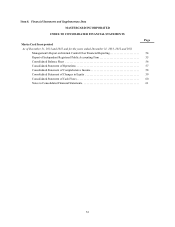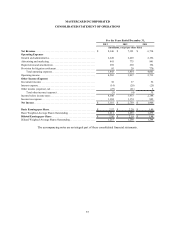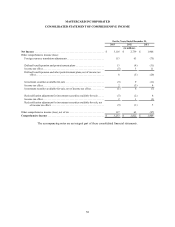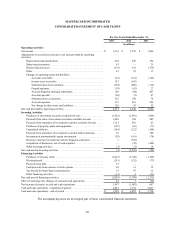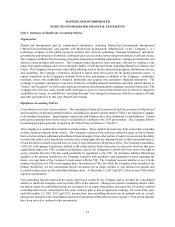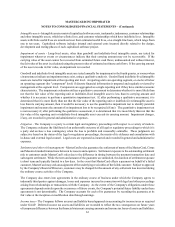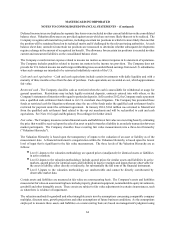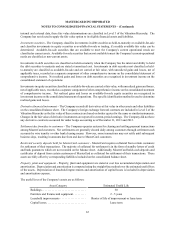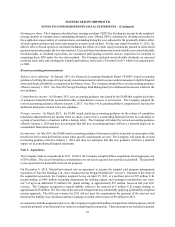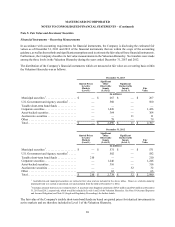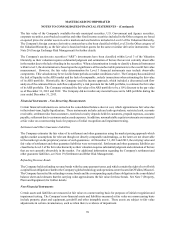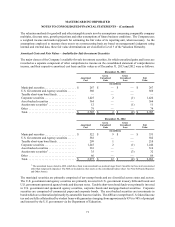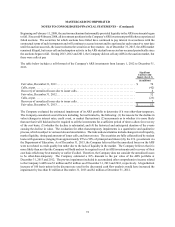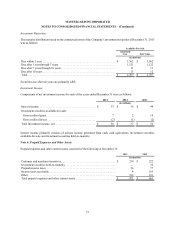MasterCard 2013 Annual Report Download - page 67
Download and view the complete annual report
Please find page 67 of the 2013 MasterCard annual report below. You can navigate through the pages in the report by either clicking on the pages listed below, or by using the keyword search tool below to find specific information within the annual report.MASTERCARD INCORPORATED
NOTES TO CONSOLIDATED FINANCIAL STATEMENTS – (Continued)
63
Intangible assets - Intangible assets consist of capitalized software costs, trademarks, tradenames, customer relationships
and other intangible assets, which have finite lives, and customer relationships which have indefinite lives. Intangible
assets with finite useful lives are amortized over their estimated useful lives, on a straight-line basis, which range from
one to ten years. Capitalized software includes internal and external costs incurred directly related to the design,
development and testing phases of each capitalized software project.
Impairment of assets - Long-lived assets, other than goodwill and indefinite-lived intangible assets, are tested for
impairment whenever events or circumstances indicate that their carrying amount may not be recoverable. If the
carrying value of the asset cannot be recovered from estimated future cash flows, undiscounted and without interest,
the fair value of the asset is calculated using the present value of estimated net future cash flows. If the carrying amount
of the asset exceeds its fair value, an impairment is recorded.
Goodwill and indefinite-lived intangible assets are tested annually for impairment in the fourth quarter, or sooner when
circumstances indicate an impairment may exist, using a qualitative analysis. Goodwill and indefinite-lived intangible
assets are tested for impairment at the reporting unit level. A reporting unit is an operating segment, or one level below
an operating segment (the "component" level) if discrete financial information is prepared and regularly reviewed by
management at the segment level. Components are aggregated as a single reporting unit if they have similar economic
characteristics. The impairment evaluation utilizes a qualitative assessment to determine whether it is more likely than
not that the fair value of the reporting unit or indefinite-lived intangible asset is less than its carrying amount and
whether it is necessary to perform a quantitative impairment test. If, after performing a qualitative assessment, it is
determined that it is more likely than not that the fair value of the reporting unit or indefinite-lived intangible asset is
less than its carrying amount, then it would be necessary to use the quantitative impairment test to identify potential
impairment and measure the amount of an impairment loss to be recognized (if any). The quantitative impairment test
is not necessary if, after performing the qualitative assessment, it is determined that it is more likely than not that the
fair value of the reporting unit or indefinite-lived intangible asset exceeds its carrying amount. Impairment charges,
if any, are recorded in general and administrative expenses.
Litigation - The Company is a party to certain legal and regulatory proceedings with respect to a variety of matters.
The Company evaluates the likelihood of an unfavorable outcome of all legal or regulatory proceedings to which it is
a party and accrues a loss contingency when the loss is probable and reasonably estimable. These judgments are
subjective based on the status of the legal or regulatory proceedings, the merits of its defenses and consultation with
in-house and external legal counsel. Legal costs are expensed as incurred and recorded in general and administrative
expenses.
Settlement and other risk management - MasterCard's rules guarantee the settlement of many of the MasterCard, Cirrus
and Maestro-branded transactions between its issuers and acquirers. Settlement exposure is the outstanding settlement
risk to customers under MasterCard's rules due to the difference in timing between the payment transaction date and
subsequent settlement. While the term and amount of the guarantee are unlimited, the duration of settlement exposure
is short term and typically limited to a few days. In the event that MasterCard effects a payment on behalf of a failed
customer, MasterCard may seek an assignment of the underlying receivables of the failed customer. Subject to approval
by the Company's Board of Directors, customers may be charged for the amount of any settlement loss incurred during
the ordinary course activities of the Company.
The Company also enters into agreements in the ordinary course of business under which the Company agrees to
indemnify third parties against damages, losses and expenses incurred in connection with legal and other proceedings
arising from relationships or transactions with the Company. As the extent of the Company's obligations under these
agreements depends entirely upon the occurrence of future events, the Company's potential future liability under these
agreements is not determinable. The Company accounts for each of its guarantees by recording the guarantee at its
fair value at the inception or modification date through earnings.
Income taxes - The Company follows an asset and liability based approach in accounting for income taxes as required
under GAAP. Deferred income tax assets and liabilities are recorded to reflect the tax consequences on future years
of temporary differences between the financial statement carrying amounts and income tax bases of assets and liabilities.


